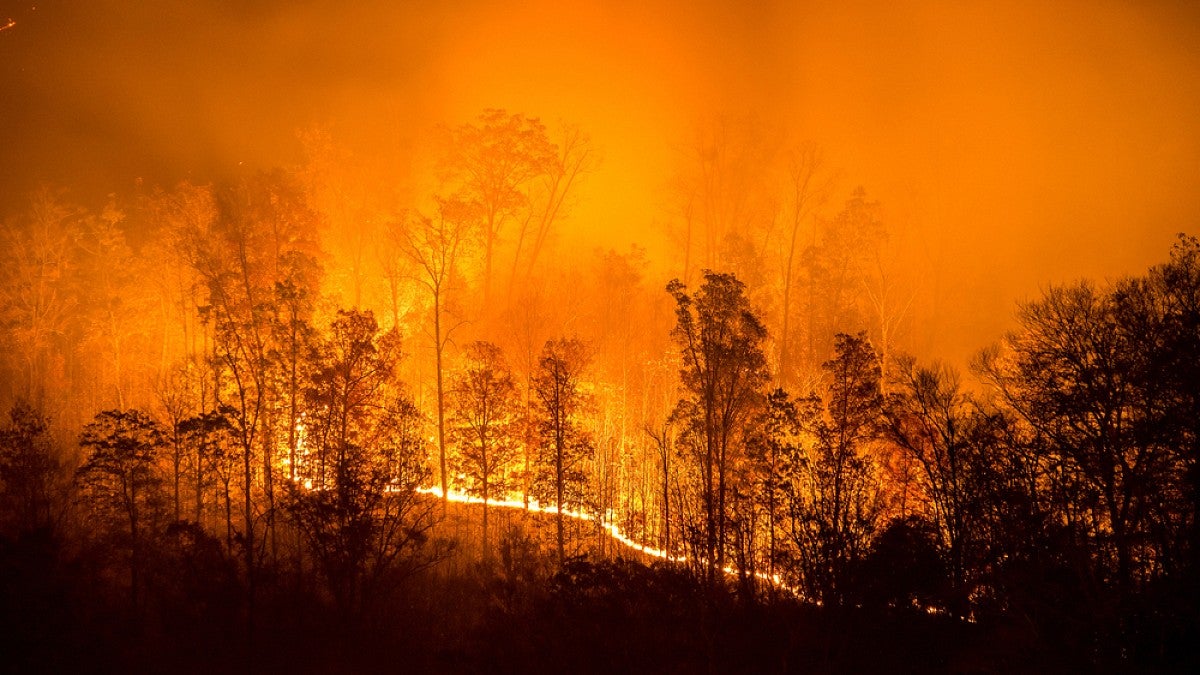A team of investigators from four universities, led by Bart Johnson, a University of Oregon landscape architecture professor, will be heading into the Intermountain West over the next four years to explore how people and organizations in wildfire-prone areas interact and organize in the face of increasing wildfire.
The project aims to understand how social networks of stakeholders collaborate to manage wildfire risk and apply the lessons in computer-simulation testing of how people can better adapt to increasing risk under climate change and population growth.
“Wildfires are worse now than in the past,” Johnson said. “They will continue to get worse because of changes in climate, the buildup of fuels such as brush in forests, and the influx of new people into wildland-urban interfaces. More people are being exposed to increasing levels of threat.”
The project began Oct. 1 under a $1.6 million grant from the National Science Foundation. It features collaborators at Oregon State University, Portland State University and the University of Florida, who will conduct studies and build models that rely on integrating principles of sociology and information theory.
“We’re primarily looking at how relationships among people affect wildfire management and whether reorganizing those relationships could reduce future losses of people and homes,” Johnson said.
Areas to be targeted include communities around Wenatchee, Washington, and Bend. Two additional regions will be chosen from sites in Colorado, Montana, New Mexico and Utah.
Small teams of students from the three Oregon universities, most of them undergraduates from underrepresented communities, will meet with farmers, ranchers, community residents, watershed councils and agencies connected to wildfire issues. A key focus will be understanding how the dynamics of things like trust, partnerships and funding all play out when people share information intended to influence on-the-ground actions.
“We’re building on our past work in simulating wildfire under different scenarios of climate change and rural development,” Johnson said. “This time, we’re doing a combination of empirical studies in the four study areas, working closely with people in local wildfire networks, to understand the patterns of relationships that may be most useful for building their adaptive capacity. Are there repeatable types of patterns that appear to enhance peoples’ ability to respond effectively to increasing risk? What’s helping? What’s getting in the way?”
In the project’s first year, Johnson and colleagues will develop a theoretical framework for adaptive capacity that can act as a bridge between their empirical and modeling work. Their explorations of questions about how organizational culture and an individual’s leadership qualities may interact to influence change will both guide their surveys of people in these communities and allow them to incorporate the results into the simulation model.
The integrated outcomes, Johnson said, will allow stakeholders to explore how reorganizing wildfire social network relationships could help people adapt to larger, more frequent and more intense wildfires.
Starting in 2020, a small team of undergraduate students recruited by Johnson’s Oregon State collaborators Dwaine Plaza, a sociologist, and Lisa Gaines, director of the Institute of Natural Resources, will work with environmental scientist Max Nielsen-Pincus, formerly at the UO and now with Portland State University, and Brent Steel, a political scientist and director of the Public Policy Graduate Program at Oregon State, to begin the outreach in one of the areas.
Eventually, other groups of students from OSU, UO and Portland State will be added. They will work closely with graduate students under the supervision of the team’s seven senior researchers.
Student recruitment, Johnson said, is targeted toward those who could particularly benefit from the project’s focus on the science of integrated socio-ecological systems.
“These will be students — a number of them first-generation students from African-American, Hispanic and Native American communities — for whom it could be useful to gain experience in the scientific and community engagement exercises that we’ll be conducting,” he said. “Our hope is that they’ll get training not only in applied research methods but also in community outreach techniques. We want them to learn how to bring these skills and ideas into local conversations about wildfire and smoke.”
Some of the students, he said, probably will come from urban areas where they may have had little personal exposure to wildfire or its smoke. The training the students receive, Johnson said, will culminate when they return to their high schools of origin to share how adaptive strategies can be useful for not only wildfires but other natural disasters, such as floods, tornadoes and hurricanes that are increasing due to climate change.
Other researchers collaborating on the grant are: David Hulse, formerly a UO professor of landscape architecture who now heads the Florida Institute for Built Environment Resilience at the University of Florida, and John Bolte, head of biological and agricultural engineering at Oregon State, who created the computer simulation model the team will continue to develop.
—By Jim Barlow, University Communications


